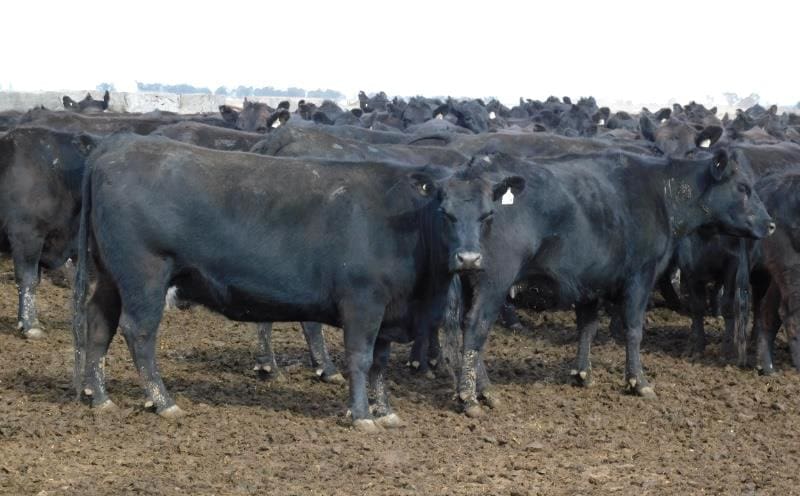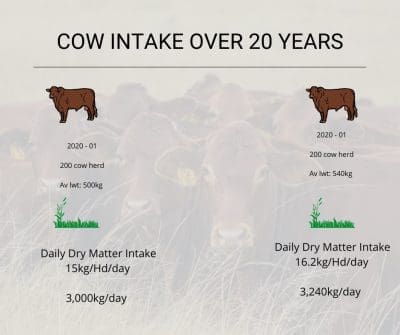
Part of a line of 198 six year old Angus cows averaging well over 600kg sold on AuctionsPlus recently
INCREASING cow size is a common source of discussion among breeders and commercial producers. As noted last year on Beef Central, mature cow sizes have been increasing.
Angus Australia noted the genetic increases of mature cow weights is around 2kg per year, with the average Angus cow now weighing around 40kg more when compared to average weights in 2000.
From a commercial producer’s perspective, cow weights are a subject that should be considered as part of an overall breeding strategy.
Cow weight has a significant impact on overall productivity of a breeding business. However, it’s important to recognise that cow weight is influenced by a number of factors.
The size and weight of a cow has a direct impact on the feeding program of a beef business. As a general guide, as a cow increases in weight, so does her feed intake.
Dry Matter Intake (DMI) increases in line with cow weight. However, DMI will also vary due to the productive state of a cow – lactation increasing intake compared to that of a dry cow.
It is important to recognise that DMI reflects the amount of feed an animal requires each day. In terms of how efficient cows are at metabolising energy and other nutrients, heavy cows actually have slightly lower nutrient requirements per unit of live weight.
The challenge for many producers is they are often focused on herd numbers to the detriment of herd productivity
Research presented by Assistant Prof Jason Smith of Texas A & M University in the United States showed that for every 45kg increase in liveweight, there was a 3.5pc reduction in nutrient requirements when expressed per unit of liveweight. But that slight increase in efficiency was outweighed by a 6px increase in DMI.
 In practical terms – bigger heavier cows may be slightly more efficient at maintaining their weight on slightly lower quality feed, but they need to eat more to do it.
In practical terms – bigger heavier cows may be slightly more efficient at maintaining their weight on slightly lower quality feed, but they need to eat more to do it.
Keeping the focus on a breeding herd, the challenge for many producers is they are often focused on herd numbers to the detriment of herd productivity.
In practice, this translates to focusing on running a specific number of breeding cows. If a herd was running 200 cows in 2000-01, that continues to be the objective in 2022-23. However a total focus on numbers may mask some issues being created by the gradual increase of cow size over that period of time.
Using the example of a producer focused on 200 cows, the increase of mature cow weight over time will lead to a corresponding increase in daily (and annual) dry matter intake.
While an increase of 240kg/day may not seem significant, in practical terms this could see periods of time when feed demand exceeds pasture supply for longer periods. This could see that imbalance impacting a producers’ plans for joining, calving or for other production goals.
The flow-on effect of an imbalance of Dry Matter Intake to feed production is generally expressed through animal fatness as well as through weight gain or weight loss.
Victorian DPI data identifies that a single Fat Score is the equivalent of 70kg in cow liveweight. As producers seek to achieve a fat score or manage breeders according to fat score, the additional weight associated with increased fatness on top of higher mature weights extends imbalance between feed and Dry Matter Intake.
Producers should be conscious of the trend of higher mature cow weights both within breeds generally and specifically within their own herds.
Without regular weighing of mature cows and reviewing herd trends, it is possible that over time producers who remain focused only on total herd numbers could find the ‘creep’ of mature cow weights impacting on herd productivity.
Ongoing monitoring can also be of value in sire selection as producer can identify and look for sires that have lower Mature Cow Weight EBVs if that is a trait that needs attention within a herd.
 Alastair Rayner is the Principal of RaynerAg, an agricultural advisory service based in NSW. RaynerAg is affiliated with BJA Stock & Station Agents. He regularly lists and sell cattle for clients as well attending bull sales to support client purchases. Alastair provides pre-sale selections and classifications for seedstock producers in NSW, Qld and Victoria. He can be contacted here or through his website www.raynerag.com.au
Alastair Rayner is the Principal of RaynerAg, an agricultural advisory service based in NSW. RaynerAg is affiliated with BJA Stock & Station Agents. He regularly lists and sell cattle for clients as well attending bull sales to support client purchases. Alastair provides pre-sale selections and classifications for seedstock producers in NSW, Qld and Victoria. He can be contacted here or through his website www.raynerag.com.au

Hi Alister. An interesting topic that seems to come up regularly. We look at the impacts of changing the breeder cow average bodyweight more broadly and identify that all of the other classes of cattle are also likely to increase their bodyweight by a similar proportion. If this is the case, and the total feed supply is held constant, it is possible to find that although less breeders and other stock are run at the higher average bodyweight, fewer weaners are produced and a lower number of stock are sold, it is possible to show more profit. The summary below compares a 200 cow breeder herd at 500 kg bodyweight in the Burdekin turning off weaner steers with a herd that has cows 40kg heavier. All other classes of cattle in the model have their bodyweight changed by the same proportion and no other herd performance parameters are changed. Prices are the average for the last 5 years. The heavier cattle eat more but sell for more in total per head (not per kg), increasing the net profit of the herd by about 5.5%. The cattle are weighted in the model according to their metabolic weight. The outcome depends upon the assumed whole herd impacts of changing the cow bodyweight but some interesting outcomes are possible.
Summary 500 kg 540 kg difference
Total adult equivalents 308 308 0
Total cattle carried 294 280 -14
Weaner heifers retained 62 59 -3
Total breeders mated 200 191 -9
Total breeders mated & kept 162 155 -8
Total calves weaned 125 119 -6
Weaners/total cows mated 62.26% 62.26% 0%
Overall breeder deaths 3.00% 3.00% 0%
Female sales/total sales % 46.70% 46.70% 0%
Total cows and heifers sold 55 52 -3
Maximum cow culling age 13 13 0
Heifer joining age 2 2 0
Two yr old heifer sales % 47.25% 47.25% 0%
Total steers & bullocks sold 62 59 -3
Max bullock turnoff age 0 0 0
Avg female price $1,087.54 $1,173.76 $86.22
Avg steer/bullock price $557.45 $600.86 $43.41
Capital value of herd $284,620 $290,393 $5,773
Imputed interest $14,231 $14,520 $289
Net cattle sales $94,046 $96,687 $2,641
Direct costs ex bulls $10,475 $9,982 -$492
Bull replacement $7,559 $7,054 -$506
Gross margin for herd $76,012 $79,651 $3,639
GM after imputed interest $61,781 $65,131 $3,350
The impact of environment shouldn’t be underestimated when it comes to mature cow size. Seedstock producers should pay attention to mature cow size while ensuring they take into account their own herd’s environment. We have seen first hand the considerable impact environment has on our clients herds in different areas of the country. This can be attributed to the available nutrition for the growing calf which dictates weaning weight and the ongoing nutrition throughout the the next phase of that heifer’s growing period and her early years raising calves. This element is not a result of management but the impact of enviroment. So it is important that seedstock producers take into consideration their own environment so as not to allow mature cow weight to escalate therefore protecting their bull customers from the perils of inefficient cows in commercial herds.